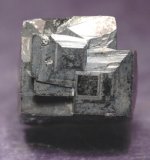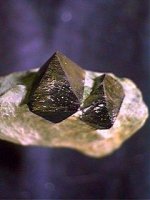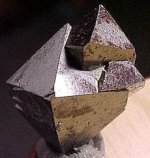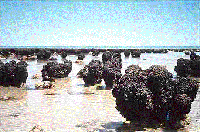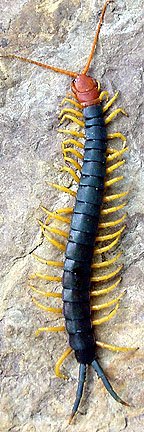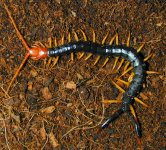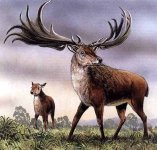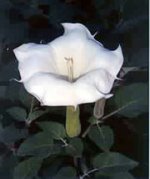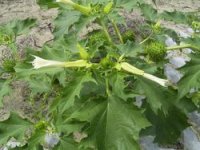a plant close to my heart
The sacred datura, illustrated on the Ironwing Tarot's 5 of bells.
the species for the illustration is not specifically indicated, but I don't
see that as any kind of particular drawback.
In Native American tribes of the southwest, as is often the case with tribes elsewhere, in rites of passage, a young person coming of age would fast and pray for days in order to purify himself. In some cases, the initiate might be isolated or left in the wild alone. At the appropriate time, a Medicine person or tribal spiritual elder that would nominally be called by others than Native Americans, a Shaman, might accompany the initiate to a holy place, possibly a mountain top or cave, and a tea would be made from the roots, leaves and even the seeds from the prickly seed pod of a plant called Sacred Datura. The individual would drink this tea and wait for visions, and the initiate would definitely have visions.
Besides those sacred rites of passage, Datura, which is refered to in some cultures as la Yerba Del Diablo, but known to the Chumash people of California, the Mohave, Yuma, Cahuilla, Zuni and others as toloache from the Aztec toloatizn, "to incline the head" (and the person adminstering the Datura as a tolachero), has been used to hex and to break hexes, to produce sleep and induce dreams, and for protection from evil. It has also been used for Divination, to find one's totem animal, to allow one to see ghosts, for communing with birds, for long hunts and strength, for sharper vision, for sorcery and to increase supernatural powers. Like other tropane-containing plants that have been used historically for so called Flying Ointments, Sacred Datura has been used in certain rituals related to inducing the ability to fly through eating or drinking and sometimes an ointment (see). Datura is still widely used in the Caribbean for the same or similar reasons as well, and called there "herbe aux sorciers" (herb of the sorcerers) among the various French speaking islanders. On the English speaking islands, Jamaica for example, those who practice the spellcraft Obeah are also known to incorporate almost interchangeably with Datura another Nightshade herb they call Branched Calalue.
SACRED DATURA: Nightshade Family [Solanaceae] is found in western Texas, New Mexico, Colorado, Utah, Arizona, southern California, Mexico, and the West Indies and grows within an elevation range between sea level and 6,500 feet. The name Datura, its generic name, is from the Hindu Dhatura (dhat=the eternal essence (of God)), which was derived from the Sanskrit name D'hastura. Sacred Datura bloom at night starting early evening and typically closing around noon the following day. They are pollinated by nocturnal visitors, usually sphinx or hawk moths.
The tea from Datura is extremely hallucinogenic. The hallucinogenic effects are reported to be stronger than Peyote, Psyillicibin, or LSD. However, Datura is also very toxic and can cause permanent psychosis. Solanaceous plants such as Sacred Datura contain relatively high concentrations of tropane alkaloids, primarily Atropine, Hyoscyamine, and Scopolamine, the primary alkaloid being Scopolamine. It is apparently Scopolamine that produces the hallucinogenic effects. It induces an intoxication followed by narcosis in which hallucinations occur during the transition state between consciousness and sleep.
When Datura is used in a Native American ritual, it is always under the guidance of an individual of certain tribal spritual resolve such as a Medicine person or tribal elder. These experts on the use of the plant know what other plants to add in order to neutralize the harmful effects. They also know how much to adminsister and when and where to pick the plants, such as age, season, time of year, whether under a full moon or no moon at all. Chemical constituents and levels vary greatly from plant to plant, time of year, and from one area to another just generally, but especially so if the plants are obtained through ritual or from a spot known for having special powers like the Sun Dagger site on Fajada Butte in Chaco Canyon, New Mexico, holy places of some sort such as Vortexes, or sacred grounds. The plants are very toxic, poisonous and lethal, especially if consumed in quanities unmetered by someone not versed in their safe administration. They can, however, when properly dealt with, produce the end result sought after, and quite adequately so, in the spiritual realm.
Although typically connected with Peyote in the minds of the general public, one of the formost users of Datura was Carlos Castaneda who claimed its use as an apprentice to a Yaqui Indian shaman-sorcerer named Don Juan Matus that is said to have studied under a Diablero.
In that there are a number of species of Datura there is some confusion as to what Datura Castaneda may have used. According to Castaneda in THE TEACHINGS OF DON JUAN: A Yaqui Way of Knowledge a shaman-sorcerer has an ally contained in the Datura plants commonly known as jimson weed. Don Juan called that ally by one of the Spanish names of the plant, yerba del diablo (devil's weed). According to Don Juan, as he related it to Castaneda, ANY of the species of Datura was the container of the ally. However, the sorcerer had to grow his own patch, not only in the sense that the plants were his private property, but in the sense that they were personally identified with him.
As for the "separate" Daturas, more or less on an official basis --- but not necessarily on a common basis as the names, species and terms are usually intermixed (although it must be said, even plant taxonomist disagree amongst themselves whether D. stramonium and D. inoxia are different species while D. inoxia and D. metaloides are considered alternate names for the same species). Usually, D. stramonium is most often the Datura species refered to as jimson weed, while D. metaloides (also sometimes D. wrightii) is usually applied to Sacred Datura, and D. inoxia is Toloache.
all that information lifted wholesale from this page:
http://www.angelfire.com/indie/anna_jones1/datura.html
and children, pay particular attention to the point made about the chemical
constituents of this genus being highly toxic and dangerous. the point bears
repeating: "can cause permanent psychosis".
No modern psychedelic shamans would choose undergoing the ordeal of
ingesting this substance as a recreational high, and *few* are qualified
to endure it or benefit from it, in the pursuit of spiritual enlightenment.

